Motion Pictures and the Social Attitudes of Children
Chapter 2: The Effect of Single Pictures
Ruth C. Peterson & L.L. Thurstone
Table of Contents | Next | Previous
"Four Sons" and the Germans
The first of a series of experiments carried on in small towns was conducted in Genoa, Illinois, a town with a population of about 1,200.[1] The experimental group consisted of 133 children in grades seven to twelve inclusive. With the coöperation of Mr. Cloy S. Hobson, principal of the Genoa Township High School, the following three schedules were given in the school on April 17, 1930:
(1) a scale of attitude toward Germans.
(2) a paired comparison of nationalities.
(3) a scale of attitude toward war.
On April 29 the motion picture "hour Sons" was shown at a special matinée performance in the local theater. The three schedules were given again in the school the following morning, April 30.
The scale of attitude toward the Germans had the following directions and statements. The scale values, which are given here, were not, of course, given on the form presented to the students.
(6)
A STUDY OF ATTITUDE TOWARD THE GERMAN PEOPLE
Write your name here:
Boy or girl Age Grade
Father born in ________ Mother born in ________
(Name of country) (Name of country)
This is a study of attitudes toward German people. On the other side of this page you will find a number of statements expressing different attitudes toward the Germans.Put a check mark if you agree with the statement.
Put a cross if you disagree with the statement.
Try to indicate either agreement or disagreement for each statement. I f you simply cannot decide about a statement you may mark it with a question mark.
This is not an examination. There are no right or wrong answers to these statements. This is simply a study of people's attitudes toward German people. Please indicate you own convictions by a check mark when you agree and by a cross when you disagree.
| 4.6 | 1. The Germans as a race are very pleasant people. |
|---|---|
| 9.1 | 2. I'm prejudiced against people of German descent. |
| 6.4 | 3. German people are no better and no worse than any other people. |
| 1.8 | 4. I admire the German people unreservedly. |
| 12.3 | 5. The German people are the most despicable people in the world. |
| 4.1 | 6. Some of our best American citizens are of German descent. |
| 0.7 | 7. The German people are the finest in the world. |
| 10.6 | 8. The German soldiers were, almost without exception, cruel and brutal. |
| 8.4 | 9. Germans are slow and unimaginative. |
| 3.7 | 10. The more I know about the German people the better I like them. |
| 11.5 | 11. If Germany had been wiped out by the war the world would be better off. |
| 7.4 | 12. I don't object to German people but I don't like the German Government. |
| 4.8 | 13. The German people were not responsible for and did not want war. |
| 9.7 | 14. I don't trust the Germans. |
| 9.1 | 15. The German military officer is typical of the German people. |
| 9 | 16. German parents are harsh to their children. |
| 11.9 | 17. I hate all the Germans. |
| 4 | 18. The rank and file of the German army were kindly, admirable young men. |
| 2.7 | 19. The Germans are the most desirable class of immigrants. |
| 3.4 | 20. I'd rather have my sister marry a German than any other foreigner. |
| 5.7 | 21. The arrogance of the German officer is not typical of the German people. |
| 7 | 22. I have no particular love nor hate for the Germans. |
| 10.9 | 23. There is nothing about Germans that I could ever like. |
| 7.8 | 24. I suppose Germans are all right but I've never liked them. |
| 3 | 25. German home life is ideal. |
| 10.4 | 26. The people of Germany are gluttonous, militaristic, and overbearing. |
| 0.5 | 27. Germans are superior to any other nationality. |
(7)
Each individual's score was the median scale value of all the statements he indorsed.
Figure 1 presents two frequency distributions which show the effect of the film "Four Sons" on the children's attitude toward Germans, as measured by the statement scale. The mean attitude of the group before seeing the film was 5.66; after seeing the picture it was 5.28. This difference of .38 represents a change in attitude favorable to the Germans. The RE.,, is .0708, and the ratio of the difference to the RE.,, is 5.37. The statistical facts about the two distributions are given below.
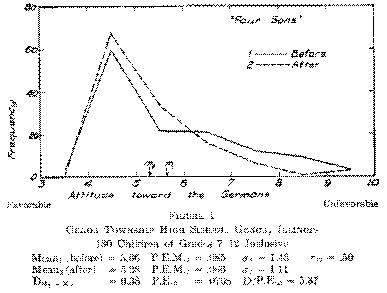
The conclusion that the film made the children definitely more favorable to the Germans seems to be justified.
The paired comparison of nationalities had the following directions:
( 8)
A STUDY OF NATIONALITY PREFERENCES
Write your name here
Boy or girl Age Grade
Father born in Mother born in
(Name of country) (Name of country)
This is a study of attitudes toward nationalities. You are asked to underline the one nationality of each pair that you would rather associate with. For example, the first pair is:
Englishman-Norwegian
If, in general, you prefer to associate with Englishmen rather than with Norwegians, underline Englishman. If you prefer, in general, to associate with Norwegians, underline Norwegian. If you find it difficult to decide for any pair, be sure to underline one of them anyway. If two nationalities are about equally well liked, they will have about the same number of underlinings in all of the papers. Be sure to underline one of each pair even if you have to guess.
| Englishman Norwegian | Greek-Pole | |
| Swede-Belgian | German-Austrian | |
| Russian-Norwegian | Irishman German | |
| Norwegian-Italian | Hollander-Scotchman | |
| Norwegian-Irishman | Swede-Norwegian | |
| Swede-Russian | Greek-Irishman | |
| Russian-Austrian | Irishman-Frenchman | |
| Norwegian-Spaniard | German-Norwegian |
There were 15 nationalities in the list making a total of 105 comparisons of the type illustrated above.
Figure 2 shows the scale values, before and after seeing the film, for each of the nationalities which appeared in the paired comparison schedule. It is evident that the largest shift in scale value appears in the case of the Germans. It shows clearly that the film made the children more friendly toward the Germans. The shifts in scale value for the other nationalities are smaller, and most of them are of the order of magnitude which would be expected by the chance errors
(
9)
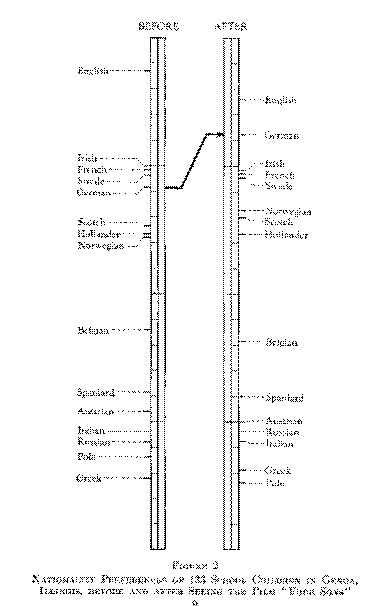
( 10) in the proportions from which the scale values were determined.
The preferences before and after for each pair of which German was a member are tabulated below.
| PAIRED COMPARISON OF NATIONALITIES | ||||
|---|---|---|---|---|
| Nationality | Before | After | Difference | |
| Pole-German | 18-112 | 10-120 | 8 | |
| German-Italian | 108- 22 | 118- 12 | 10 | |
| Belgian-German | 38- 92 | 27-103 | 11 | |
| German- Englishman | 49- 80 | 60- 69 | 11 | |
| Frenchman-German | 66- 64 | 56- 74 | 10 | |
| Greek-German | 22-108 | 10-110 | 2 | |
| German-Spaniard | 101- 29 | 112- 18 | 11 | |
| Hollander-German | 50- 80 | 40- 90 | 10 | |
| German-Austrian | 105- 25 | 113- 17 | 8 | |
| Irishman-German | 76- 54 | 63- 67 | 13 | |
| German-Norwegian | 78- 52 | 81- 49 | 3 | |
| Scotchman-German | 62- 68 | 57- 73 | 5 | |
| German-Russian | 108- 22 | 115- 15 | 7 | |
| Swede-German | 66- 64 | 53- 77 | 13 | |
In every one of the above comparisons there was a change in attitude favorable to the Germans as a result of the film "Four Sons." The effect of the film on attitude is here very clearly shown. It is interesting to note that the Germans gained most (in number of shifts) at the expense of the Swedes and of the Irish.
"Four Sons" and war
Attitude toward war was measured by the following scale. (The scale values did not appear on the form given to the students.)
AN EXPERIMENTAL STUDY OF ATTITUDE TOWARD WAR
Write your name here
Boy or girl _Age Grade
Father born in Mother born in
(Name of country) (Name of country)
This is a study of attitudes toward war. On the following pages you will find a number of statements expressing different attitudes toward war.
,/ Put a check mark if you agree with the statement.
X Put a cross if you disagree with the statement.
(11)
Try to indicate either agreement or disagreement for each statement. If you simply cannot decide about a statement you may mark it with a question mark.
This is not an examination. There are no right or wrong answers to these statements. This is simply a study of people's attitudes toward war. Please indicate your own convictions by a check mark when you agree and by a cross when you disagree.
| 7.9 | 1. Wars often right tremendous wrongs. |
|---|---|
| 1.2 | 2. War appeals only to the basest of human motives and brings out all that is brutal in humanity. |
| 5.6 | 3. Defense is the only justification for war. |
| 2 | 4 War maims and kills the finest of the nation's manhood, leaving the physically unfit as a basis for coming generations. |
| 4 | 5. It is almost impossible to have a large military force without being tempted to use it. |
| 5.6 | 6. Peace and war are both essential to progress. |
| 8.6 | 7. The abolition of war might result, through the loss of fighting energy, in the fall of civilization. |
| 2.9 | 8. A host of young men entered the war in a spirit of idealism and unselfish devotion to a great cause, only to return disillusioned and cynical as to the value of ideals. |
| 1.5 | 9. War in the modern world is as needless as it is suicidal. |
| 0.4 | 10. All nations should disarm immediately. |
| 2.3 | 11. War brings misery to millions who have no voice in its declaration. |
| 9 | 12. Militarism is necessary for the proper defense and protection of the individuals of a country. |
| 9.7 | 13. A country cannot amount to much without a national honor, and war is the only means of preserving it. |
| 4 | 14. An organization of all nations is imperative to establish peace. |
| 0.3 | 15. There is no conceivable justification for war. |
| 6.6 | 16. We should have a moderate amount of military training in our schools. |
| 5.8 | 17. Wars are justifiable only when waged in defense of weaker nations. |
| 1.9 | 18. In an aggressive war, the individual citizen should refuse to answer the call to arms. |
| 3.6 | 19. No scheme of aggression or conquest can be pursued for any considerable length of time without enfeebling victor as well as vanquished. |
| 10.5 | 20. Might is right. |
| 5.2 | 21. Only in a war in which moral issues are clearly at stake is the individual under obligation to serve. |
| 7.4 | 22. Until an equivalent discipline is organized, war must have its own way. |
| 6.8 | 23. Because right may be more important than peace, war may be the lesser of two evils. |
| 10 | 24. War is ennobling and stimulating of the highest and best qualities of humankind. |
| 0.9 | 25. The war makers should be jailed, and we should honor the heroes of peace. |
| 9.5 | 26. War is the tonic of races. |
| 5 | 27. Peace will come spontaneously without any effort on our part. |
| 9.2 | 28. In the supreme offer of his life on the battle-field, a man attains to the greatest heights of glory. |
(12)
| 8.3 | 29. The benefits of war outweigh its attendant evils. | |
|---|---|---|
| 4.7 | 30. Nations should agree not to intervene with military force in purely commercial or financial disputes. | |
| 5.4 | 31. The most that we can hope to accomplish is the partial elimination of war. | |
| 7.8 | 32. If a man's country enters a war which he does not consider justified, he should, nevertheless, serve at the front or wherever he is needed | |
| 0.4 | 33. He who refuses to fight is a true hero of war. | |
| 0.3 | 34. It is the moral duty of the individual to refuse to participate in any way in any war, no matter what the cause. | |
| 3.4 | 35. Civil and national differences can be settled without war. | |
| 2.6 | 36. The disrespect for human life and rights involved in war is a cause of crime waves. | |
| 4.5 | 37. The evils of war are slightly greater than its benefits. | |
| 8.5 | 38. When war is declared, we must enlist. | |
| 1.6 | 39. It is difficult to imagine any situation in which we should be justified in sanctioning or participating in another war. | |
| 6.9 | 40. It is our duty to serve in a defensive war. | |
| 6.2 | 41. Those military units should be retained which afford training to the body and mind. | |
| 10.4 | 42. There is no progress without war. | |
| 0.6 | 43. Persons should pledge themselves never to aid any future war. | |
| 3.2 | 44. The misery and suffering of war are not worth its benefits. |
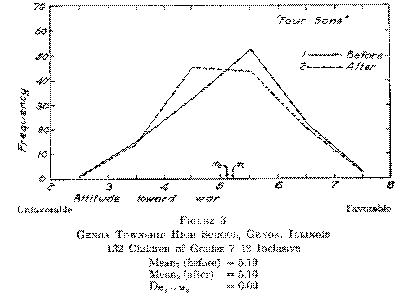
( 13)
Figure 3 shows the distributions of attitude toward war before and after seeing the film "Four Sons." The mean score of the group before was 5.19, after 5.10. The change is not large but it is in the expected direction.
In conclusion we may say that the film "Four Sons" made the children more favorable to the Germans and slightly less favorable to war.
"Street of Chance" and gambling
An experiment was conducted in Mendota, Illinois, a town with a population of about 4,000, to study the effect of the motion picture "Street of Chance" on the children's attitudes toward gambling.[1] The experimental group consisted of 240 children in grades nine to twelve inclusive in Mendota Township High School, of which Mr. M. E. Steele is principal. A paired comparison of minor crimes was given in the school on May 15, 1930. The paired comparison schedule had the following instructions
A STUDY OF ATTITUDE TOWARD CRIME
Write your name here
Boy or girl Age Grade
This is a study of attitudes toward crime. You are asked to underline the one crime of each pair that you think should be punished most severely. For example, the first is:
speeder-pickpocket
If, in general, you think a speeder should be punished more severely than a pickpocket, underline speeder. If you think a pickpocket should be punished more severely than a speeder, underline pickpocket. If you find it difficult to decide for any pair be
sure to underline one of them, even if you have to guess.
speeder-pickpocketbank robber-gambler
gambler-bootlegger pickpocket-drunkard
drunkard-beggar quack doctor-bootlegger
gangster-tramp beggar-gangster
( 14)
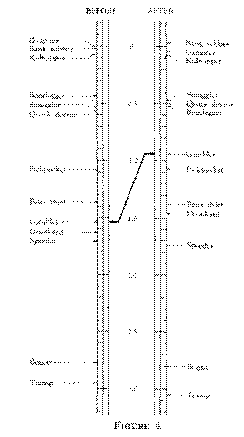
The schedule contained 78 comparisons of the type indicated. There were, 13 crimes, and each crime was paired with every other.
On May 22 the film "Street of Chance" was shown at a special matinée performance in the local theater. This film depicts the life of a gambler in such a way that the children's attitudes toward gambling might be affected. The paired comparison schedule was given again in the school the following morning, May 23.
The scale values were calculated for each crime before and after the children saw the film. Figure 4 presents the results graphically. It is evident that the scale values did not change markedly except for "gambler" which the children regarded as much worse after seeing the film.
The film "Street of Chance" may be said to have a socially approved effect, since it made the children more severe in their judgment of gambling even
( 15)
though the gambler was an interesting, likeable character in the film.
"Hide Out " and prohibition
In Princeton, Illinois, a town of approximately 4,700 people, the experimental group consisted of 254 children in grades nine to twelve inclusive.' Mr. 0. V. Shaffer, principal of the Princeton Township High School, assisted us in the experiment. The same paired comparison of minor crimes that was given in Mendota and a scale of attitude toward prohibition was given in the Princeton High School on May 19, 1929. The scale of attitude toward prohibition contained the following directions and statements (the scale values did not appear on the form given to the students)
A STUDY OF ATTITUDE TOWARD PROHIBITION
Write your name here
Boy or girl Age Grade
This is a study of attitude toward Prohibition. On the other side of this page you will find a number of statements expressing different attitudes toward
Prohibition.
.,/ Put a check mark if you agree with the statement.
X Put a cross if you disagree with the statement.
Try to indicate either agreement or disagreement for each statement. If you simply cannot decide about a statement you may mark it with a question mark.
This is not an examination. There are no right or wrong answers to these statements. This is simply a study of people's attitudes toward Prohibition. Please indicate your own convictions by a check mark when you agree and by a cross when you disagree.
| 5.5 | 1. It is absolutely immaterial whether we have prohibition or not. |
|---|---|
| 8.6 | 2. The Eighteenth Amendment should be repealed and local option adopted. |
| 6.4 | 3. Prohibition should come as the result of education, not legislation. |
| 0.8 | 4. The entire state and national resources should be mobilized for prohibition enforcement. |
| 8.2 | 5. Liquor should be sold by licensed liquor dealers in restricted amounts. |
(16)
| 0.4 | 6. Prohibition should be retained at all costs. |
|---|---|
| 9.3 | 7. Prohibition is undesirable because it drives the liquor traffic under ground rather than eliminates it. |
| 1.4 | 8. Possession of intoxicating liquor in any form should subject individuals to punishment. |
| 9.2 | 9. Prohibition should be a matter to be decided by the individual, and not by the government. |
| 3.5 | 10. The present prohibition laws are necessary for the good of the United States. |
| 7.5 | 11. Manufacture of wines and beer in the home should be permitted. |
| 10.4 | 12. The open saloon system should be universally permitted. |
| 6.9 | 13. Prohibition is not desirable now because there is not a sufficiently large majority in favor of it to make enforcement effective. |
| 5.6 | 14. Both good and bad results have come from the Eighteenth Amendment. |
| 10.2 | 15. Prohibition has been tried and has proved a miserable failure. |
| 3.7 | 16. While the Eighteenth Amendment is a part of the constitution it should be observed. |
| 7 | 17. Prohibition is good in principle but it is doing more harm than good because it cannot be enforced. |
| 10.2 | 18. The Eighteenth Amendment should be repealed. |
| 2.5 | 19. Prohibition prevents many accidents and should, therefore, be enforced. |
| 4.6 | 20. It must be admitted that the Eighteenth Amendment is a restriction of personal liberty, but it has benefited many people. |
| 3.2 | 21. The national government should increase its appropriation for prohibition enforcement. |
| 4.4 | 22. Although not completely satisfactory, the present prohibition is preferable to no prohibition. |
| 3.3 | 23. The restriction of personal liberty under prohibition is entirely justified by the benefits. |
| 4.5 | 24. The experiment of prohibition may prove to have some value and may, therefore, be worth trying. |
| 7.8 | 25. Prohibition is an infringement upon personal liberty. |
| 2.4 | 26. The effect of prohibition on the national life of America is more than constructive. |
| 2.3 | 27. The present prohibition laws are satisfactory and their enforcement should be more severe. |
| 1.8 | 28. Since the liquor traffic is a curse to the human family it must be dealt with by law. |
On May 26, 1929, the film "Hide Out," which portrays the experiences of a college bootlegger, was given at a special matinée performance in the local theater. The experiment had been planned with another film, which, it was found, had already been shown in Princeton. The film "Hide Out" had been criticized for its portrayal of a college bootlegger, and it was conceivable that it might affect
(17) the children's attitudes toward bootlegging and toward prohibition.
The frequency distributions of the attitudes of the group toward prohibition are shown in Figure 5. The mean attitude score of the group before and after seeing the film shows no change.
The paired comparison schedule shows only slight variations which are due to the chance fluctuations in the experimental proportions. We conclude that the film "Hide Out" had no measurable effect on the children's attitudes toward prohibition or bootlegging.
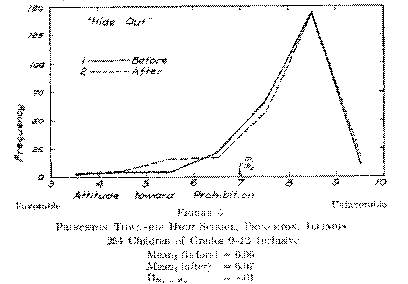
"Son of the Gods," "Welcome Danger," and the Chinese
The two following experiments were conducted in neighboring towns of comparable populations .[2] The effect of
( 18) a motion picture on the children's attitudes toward the Chinese was studied in each group, in one case with a firm which has been considered friendly toward Chinese culture and in the second with a firm which has been considered unfriendly and has, as such, been criticized by the Chinese themselves.
In Geneva, Illinois, a town of about 4,600 people, the following scale of attitudes toward the Chinese was given in the school on May 19, 1930, with the cooperation of Mr. H. M. Courtly, superintendent of schools. (The scare values, which are given here, did not appear on the form used in the experiments.)A STUDY OF ATTITUDE TOWARD THE CHINESE
Write your name hereBoy or girl Age Grade
Father born in Mother born in
(Name of country) (Name of country)
This is a study of attitudes toward the Chinese. On the other side of this page you will find a number of statements expressing different attitudes toward the Chinese.
\/ Put a check mark if you agree with the statement.
X Put a cross if you disagree with the statement.
Try to indicate either agreement or disagreement for each statement. If you simply cannot decide about a statement you may mark it with a question mark.
This is not an examination. There are no right or wrong answers to these statements. This is simply a study of people's attitudes toward the Chinese. Please indicate your own convictions by a check mark when you agree and by a cross when you disagree.
| 6.5 | 1. I have no particular love nor hate for the Chinese. |
|---|---|
| 10.1 | 2. I dislike the Chinese more every time I see one. |
| 4.7 | 3. The Chinese are pretty decent. |
| 7.2 | 4. Some Chinese traits are admirable but on the whole I don't like them. |
| 0.5 | 5. The Chinese are superior to all other races. |
| 8.7 | 6. The Chinese as part of the yellow race are inferior to the white race. |
| 3.5 | 7. 1 like the Chinese. |
| 2.8 | 8. The more I know about the Chinese the better I like them. |
| 11 | 9. The Chinese are aptly described by the term "yellow devils." |
| 1.8 | 10. The high class Chinese are superior to us. |
| 5.2 | 11. The Chinese are different but not inferior. |
| 11.5 | 12. I hate the Chinese. |
| 4.1 | 13. Chinese parents are unusually devoted to their children. |
(19)
| 7.7 | 14. Although I respect some of their qualities, I could never consider a Chinese as my friend. |
|---|---|
| 1.2 | 15. I would rather live in China than any other place in the world. |
| 9.7 | 16. There are no refined nor cultured Chinese. |
| 6 | 17. The Chinese are no better and no worse than any other people. |
| 8.4 | 18. I think Chinese should be kept out of the United States. |
| 2.2 | 19. I consider it a privilege to associate with Chinese people. |
| 10.6 | 20. The Chinese are inferior in every way. |
| 9.4 | 21. I don't see how anyone could ever like the Chinese. |
| 3 | 22. Chinese have a very high sense of honor. |
| 8.6 | 23. I have no desire to know any Chinese. |
| 1.4 | 24. Chinese people have a refinement and depth of feeling that you don't find anywhere else. |
| 9.8 | 25. There is nothing about the Chinese that I like or admire. |
| 3.9 | 26. I'd like to know more Chinese people. |
The experimental group included 230 students in grades nine to twelve inclusive. On May 26 tickets were distributed
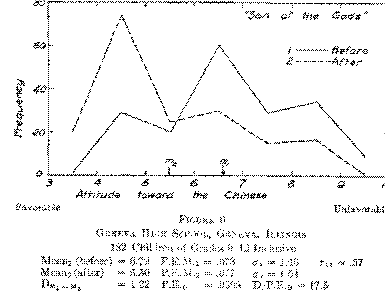
at the school which admitted the children to the regular evening performance of "Son of the Gods." "Son of the Gods" tells the story of Sam Lee who was brought up by
( 20) an admirable Chinaman, Lee Ying, who Sam Lee believed was his father. Sam Lee is an attractive, able person whom people like and admire but who is not quite accepted because he is Chinese. The interpretation of Chinese life and culture is friendly, and the Chinese characters are admirable people.
On the following morning the attitude scale was given again in the school.
Figure 6 shows the two distributions of attitude toward the Chinese before and after the children saw the film. The shift in attitude is very striking. The statistical facts about the two distributions are given in the diagram on page 19.
The difference in mean attitude scores before and after seeing the film is seventeen and one-half times the probable error of the difference. The conclusion that the film "Son of the Gods" made the children more favorable toward the Chinese is undoubtedly justified.
In West Chicago, Illinois, which has a population of about 3,400, the same scale of attitude toward the Chinese was given on the same day, May 19, 1930. "Welcome Danger" is a film filled with Harold Lloyd comedy but picturing the Tong conspirators and the lawless element of underground Chinatown and has been criticized as unfriendly toward the Chinese. It was shown in the school auditorium on May 26 by permission of Mr. C. C. Byerly, principal.
The attitude scale was repeated the morning of May 27. The experimental group included 225 children in grades nine to twelve inclusive.
Figure 7 gives the two frequency distributions representing the attitudes of the group before and after seeing the motion picture. The mean score before was 5.71; after,
( 21) 5.88, a change of .17 scale step, which is not large but is in the expected direction. The statistical facts about the two distributions appear below the diagram.
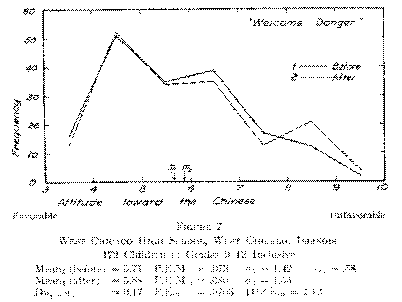
"The Valiant" and capital punishment
An experiment was conducted at Geneseo, Illinois, to study the effect of the motion picture "The Valiant" on the children's attitudes toward capital punishment. The experiment was made possible through the help of Mr. James D. Darnall, principal of Geneseo Township High School. Geneseo is a town with a population of 3,400. The experimental group consisted of 501 children in grades four to twelve inclusive. A large age range was included because we were interested in studying the differences in the effect of a motion picture on different age-groups.
(
22)
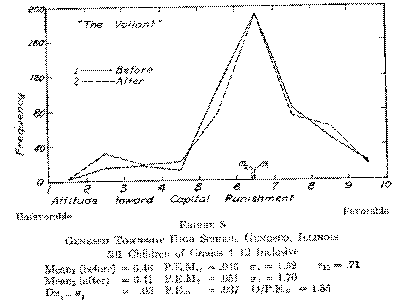
(23)
| 2.7 | 8. Capital punishment has never been effective in preventing crime. |
|---|---|
| 5.4 | 9. I don't believe in capital punishment but I'm not sure it isn't necessary. |
| 8.5 | 10. We must have capital punishment for some crimes. |
| 3.9 | 11. I think the return of the whipping post would be more effective than capital punishment. |
| 0.1 | 12. I do not believe in capital punishment under any circumstances. |
| 3 | 13. Capital punishment is not necessary in modern civilization. |
| 1.5 | 14. We can't call ourselves civilized as long as we have capital punishment. |
| 3.4 | 15. Life imprisonment is more effective than capital punishment. |
| 0.9 | 16. Execution of criminals is a disgrace to civilized society. |
| 9.6 | 17. Capital punishment is just and necessary. |
| 5.8 | 18. I do not believe in capital punishment but it is not practically advisable to abolish it. |
| 0.6 | 19. Capital punishment is the most hideous practice of our time. |
| 9.4 | 20. Capital punishment gives the criminal what he deserves. |
| 2 | 21. The state cannot teach the sacredness of human life by destroying it. |
| 5.5 | 22. It doesn't make any difference to me whether we have capital punishment or not. |
| 7.9 | 23. Capital punishment is justified only for premeditated murder. |
| 9.1 | 24. Capital punishment should be used more often than it is. |
( 24)
The two frequency distributions, representing the attitudes of the children before and after seeing the film are given in Figure S. The mean score of the group before was 6.46, after 6.41, a change of .05 scale step with a P.E.D, of .037. The ratio of the difference to the P.E.D, is 1.35 which, although it is not a significant difference, is in the expected direction.
We conclude that, although the film "The Valiant" showed a slight effect on the children's attitudes, making them less favorable to capital punishment, the effect is not statistically significant. Neither the mean attitude scores nor the amount of change showed any consistent variation from the younger to the older age groups.
"Journey's End" and warMr. H. C. Storm, superintendent of schools at Batavia, Illinois, helped us arrange an experiment in his school to study the effect of the film "Journey's End" on the children's attitudes toward war. Batavia is a town of about 5,000 people. Three hundred one children in grades seven to twelve took part in the experiment.
A scale of attitude toward war was given in the school on January 30, 1931. The motion picture "Journey's End" was shown at a special matinée performance on February 24, and the attitude scale was given again on February 25.
The scale of attitude toward war was as follows. (The scale values were not given on the experimental form.)
A STUDY OF ATTITUDE TOWARD WAR
Write your name here
Boy or girl_ Age_ Grade
Father horn in Mother born in
(Name of country) (Name of country)
This is a study of attitude toward war. On the other side of this page you will find a number of statements expressing different attitudes toward war.
~/ Put a check mark if you agree with the statement.
< Put a cross if you iii. agree with that statement.
( 25)
Try to indicate either agreement or disagreement for each statement. If you simply cannot decide about a statement you may mark it with a question mark.
This is not an examination. There are no right or wrong answers to these statements. This is simply a study of people's attitudes toward war. Please indicate your own convictions by a check mark when you agree and by a cross when you disagree.
| 4.2 | 1 | War is hardly necessary in the modern world. |
|---|---|---|
| 1.4 | 2 | War is a futile struggle resulting in self-destruction. |
| 8.3 | 3 | The desirable results of war have not received the attention they deserve. |
| 3.3 | 4 | A host of young men returned from the war disillusioned and cynical. |
| 7 | 5 | Another war would be terrible but it might be worth the price. |
| 11 | 6 | War is glorious. |
| 7.8 | 7 | War is sometimes necessary because right is more important than peace. |
| 2.1 | 8 | War destroys the finest of the nation's manhood. |
| 4.6 | 9. | We want no more war if it can be avoided without dishonor. |
| 9.5 | 10 | High idealism is born in war. |
| 6.6 | 11 | There are some arguments in favor of war. |
| 3 | 12 | There will be no more wars when people become really civilized. |
| 0 | 13 | Every last one of us should refuse to take part in any way in any war. |
| 5.5 | 14 | It is hard to decide whether wars do more harm than good. |
| 2.4 | 15 | War is an unnecessary waste of human life. |
| 6.3 | 16 | Peace and war are both essential to progress. |
| 0.4 | 17 | War should be avoided at any cost. |
| 7.5 | 18 | Under some conditions, war is necessary to maintain justice. |
| 9.2 | 19 | War develops the moral strength of men. |
| 3.2 | 20 | The benefits of war are not worth its misery and suffering. |
| 10.8 | 21 | The highest duty of man is to fight for the power and glory of his nation |
| 1.6 | 22 | War in the modern world is as needless as it is terrible. |
| 8.8 | 23 | Every man should enlist as soon as war is declared. |
| 0.2 | 24 | There is no conceivable justification for war. |
| 5.4 | 25 | War brings out both good and bad qualities in men. |
| 10.1 | 26 | There can be no progress without war. |
| 3.7 | 27. | International disputes should be settled without war. |
| 2.2 | 28. | The soldier suffers terribly and gains nothing. |
| 0.7 | 29 | War is simply murder sanctioned by governments. |
| 8.5 | 30 | War is a satisfactory way to solve international difficulties. |
| 6 | 31. | War has some benefits; but it's a big price to pay for them. |
| 9.8 | 32. | War stimulates men to their noblest efforts. |
Figure 9 represents the distributions of attitude of the group before and after seeing the picture. The change in attitude is very small, but it is in the expected direction.
The comparison of the effect of "Journey's End" and "All Quiet on the Western Front." both of which are con-
( 26) -sidered outstanding pictures and powerful as anti-war propaganda, is interesting. Next in this report we shall present the results of an experiment using the picture "All Quiet on the Western Front." In that experiment the change in attitude is very striking. There is nothing in the experimental set-up which might explain the difference, and we consider it probable that the picture "Journey's End" is too sophisticated in its propaganda for high school children. It is possible that the two pictures might have more nearly equal effects on the attitudes of adults.
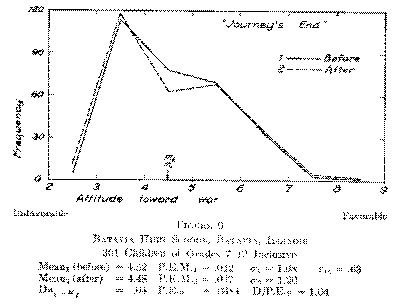
"All Quiet on the Western Front" and war
The motion picture "All Quiet on the Western Front" was shown to 214 high school students in Paxton, Illinois (population, 3,000), to study the effect of the film on attitude
( 27) toward war. Mr. John J. Swinney, principal of the Paxton Community High School, arranged to have the scale of attitude toward war given in his school on March 16, 1931. The picture was shown in the local theater on March 25, and the attitude scale was given in the school on March 26.
The attitude scale used in this experiment was the same as the scale used in the experiment at Batavia, Illinois.
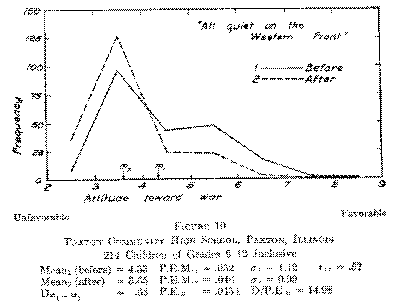
In Figure 10 we have plotted the frequency distributions of the scores on attitude toward war before and after seeing the film. The mean attitude of the group before was 4.33; after seeing the picture it was 3.65, a change of .68 of a scale step. The change is in the direction of pacifism. The P.E.Dis 0.454, the ratio of the difference to the P.E.D is 14.98.
(28)
The change in the children's attitude toward war as a result of seeing the film "All Quiet on the Western Front" is very evident.
"The Criminal Code" and punishment of criminals
The motion picture "The Criminal Code" was used in experiments at Watseka (population 3,100) and in Galesburg, Illinois (population 28,800). In Watseka the experimental group included 27G children in grades seven to twelve ; the Galesburg group included 24G students of Knox College. We wished to study the difference in the effect of this picture on high school and on college students.
Mr. E. W. Powers, principal of the Watseka Community High School, suggested that the scale of attitude toward the punishment of criminals which was used in the experiment should be simplified. He felt that some of the statements in the original form might not be easily understood by the group, especially the seventh and eighth grades. Consequently, the statements were given in the following form:
A STUDY OF ATTITUDE TOWARD PUNISHMENT OF CRIMINALS
Write your name here
Boy or girl Age Grade
This is a study of attitudes toward punishment of criminals. On the other side of this page you will find a number of statements expressing different attitudes toward punishment of criminals.
-,/ Put a check mark if you agree with the statement.
X Put a cross if you disagree with the statement.
Try to indicate either agreement or disagreement for each statement. If you simply cannot decide about a statement you may mark it with a question mark.
This is not an examination. There are no right or wrong answers to these statements. This is simply a study of people's attitudes toward the punishment of criminals. Please indicate your own convictions by a check mark when you agree and by a cross when you disagree.
| 5.8 | 1. A person should be put in prison only for very bad crimes. |
|---|---|
| 1.1 | 2. It is wrong for the government to make any people suffer in prison. |
(29)
| 9 | 3. Hard prison life will keep men from committing crime. |
|---|---|
| 4.8 | 4. Punishment does not make some criminals any better. |
| 2.7 | 5. In prison many men learn to be worse criminals. |
| 8.2 | 6. We should not bother about the comfort of a prisoner is hard. |
| 8.6 | 7. A criminal will go straight only when lie finds that prison life |
| -0.5 | 8. There isn't any punishment that will keep men from committing crime. |
| -3.1 | 9. Prisons make men worse than they were. |
| -5.5 | 10. Only men who have committed several crimes should be punished. |
| -10 | 11. We should use physical punishment in dealing with all criminals. |
| -5.3 | 12. I don't know anything about the treatment of crime. |
| -0.8 | 13. We should be ashamed to punish criminals. |
| -9.3 | 14. Putting a criminal in a cell by himself will make him sorry. |
| -4.1 | 15. It is better for us to be easy on certain criminals. |
| -1.5 | 16. Only kind treatment can cure criminals. |
| -3.1 | 17. Cruel prison treatment makes criminals want to get even. |
| -9.8 | 18. No kindness should be shown to prisoners. |
| -3.4 | 19. Many men who aren't very bad become dangerous criminals after a prison term. |
| -8.1 | 20. If we do not punish criminals, we will have more crime. |
| -10.6 | 21. Only by very cruel punishment can we cure the criminal. |
| -1.8 | 22. Severe punishment makes men worse criminals. |
| -6.4 | 23. A criminal should be punished first and then reformed. |
| -8.8 | 24. One way to keep men from crime is to make them suffer. |
| -2.3 | 25. We cannot make a good citizen of a criminal if we punish him. |
| -9.2 | 26. Having to live on bread and water in prison will cure the criminal. |
| -3.2 | 27. Cruel treatment of a criminal makes him more dangerous. |
| -7.6 | 28. A jail sentence will cure many criminals. |
| -10.3 | 29. Prisoners should be chained. |
| -4.6 | 30. In order to decide how to treat a criminal we should know what kind of person he is. |
| 0 | 31. Even the very worst criminal should not be mistreated. |
| -7.4 | 32. It is fair for the government to punish men who break the laws. |
| -2.7 | 33. Rind treatment makes the criminal want to be good. |
| -6.6 | 34. We have to use some punishment in dealing with criminals. |
February 19, 1931 was the date of the first application of the scale, the motion picture was shown in a local theater on the afternoon of March 3, and the attitude scale was given in the school the second time on March 4.
The two frequency distributions, representing the attitudes of the group before and after they saw the film, are given in Figure 11 on page 30.
The mean score before was 5.30; after, 4.80, a change of
50 of a scale step. The difference is 11.7 X P.E.,,.
The experiment conducted at Knox College, Galesburg, with the assistance of Mr. Rutledge T. Wiltbank, used the
(30) same scale of attitude toward punishment of criminals that was used in Watseka, but in its original form. It is given below.
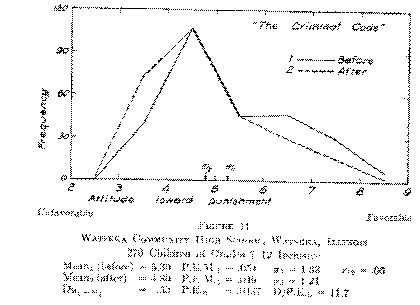
A STUDY OF ATTITUDE TOWARD PUNISHMENT OF CRIMINALS
Write your name here
Boy or girl Age Grade
This is a study of attitudes toward punishment of criminals. On the other side of this page you will find a number of statements expressing different attitudes toward punishment of criminals.
\/ Put a check mark if you agree with the statement.
X Put a cross if you disagree with the statement.
Try to indicate either agreement or disagreement for each statement. If you simply cannot decide about a statement you may mark it with a question mark.
This is not an examination. There are no right or wrong answers to these statements. This is simply a study of people's attitudes toward the punishment of criminals. Please indicate your own convictions by a check mark when you agree and by a cross when you disagree.
(31)
| -5.8 | 1. A person should be imprisoned only for serious offenses. |
|---|---|
| -1.1 | 2. It is wrong for society to make any of its members suffer. |
| -9 | 3. Hard prison life will keep men from committing crime. |
| -4.8 | 4. Some criminals do not benefit from punishment. |
| -2.7 | 5. Most prisons are schools of crime. |
| -8.2 | 6. We should not consider the comfort of a prisoner. |
| -8.6 | 7. A criminal will go straight only when he finds that prison life is hard. |
| -0.5 | 8. No punishment can reduce crime. |
| -3.1 | 9. Prison influence is degenerating. |
| -5.5 | 10. Only habitual criminals should be punished. |
| -10 | 11. We should employ corporal punishment in dealing with all criminals. |
| -5.3 | 12 I have no opinion about the treatment of crime. |
| -0.8 | 13 Punishment of criminals is a disgrace to civilized society. |
| -9.3 | 14. Solitary confinement will make the criminal penitent. |
| -4.1 | 15. It is advantageous to society to spare certain criminals. |
| -1.5 | 16. Only humane treatment can cure criminals. |
| -3.1 | 17. Harsh imprisonment merely embitters a criminal. |
| ( 9.S) | 18. No leniency should be shown to convicts. |
| -3.4 | 19. Many petty offenders become dangerous criminals after a prison term. |
| -8.1 | 20. Failure to punish the criminal encourages crime. |
| -10.6 | 21. Only by extreme brutal punishment can we cure the criminal. |
| -1.8 | 22. The more severely a man is punished, the greater criminal he be comes. |
| -6.4 | 23. A criminal should be punished first and then reformed. |
| -8.8 | 24. One way to deter men from crime is to make them suffer. |
| -2.3 | 25. Punishment is wasteful of human life. |
| -9.2 | 26. A bread and water diet in prison will cure the criminal. |
| -3.2 | 27. Brutal treatment of a criminal makes him more dangerous. |
| -7.6 | 28. A jail sentence will cure many criminals of further offenses. |
| -10.3 | 29. Prison inmates should be put in irons. |
| -4.6 | 30. We should consider the individual in treating crime. |
| 0 | 31. Even the most vicious criminal should not be harmed. |
| -7.4 | 32. It is fair for society to punish those who offend against it. |
| -2.7 | 33. Humane treatment inspires the criminal to be good. |
| -6.6 | 34. Some punishment is necessary in dealing with the criminal. |
The attitude scale was given to the college students on February 16, 1931. "The Criminal Code" was shown at a special performance in the West Theater on Saturday morning, February 28, and the attitude scale was given in the college the following Monday, March 1st.
The two distributions, before and after, are given in Figure 12. The mean attitude of the group before seeing the film was 4.95; after, 4.46, a change of .49 scale step with a
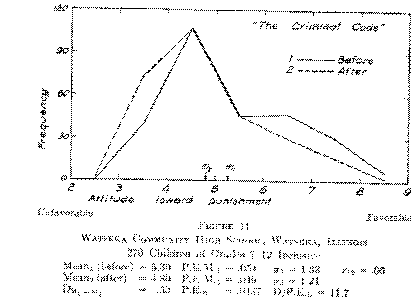
(32) P.E.D of .04, giving a ratio of the difference to the P.E.D of 12.2.
The change in attitude for the high school group (.50) is comparable to that for the college group (.49). The mean attitude of the high school group (5.30) before the motion picture, was, however, considerably higher than that of the college group (4.95). The effect of the motion picture on the college group, although slightly smaller than the effect on the high school group, may be equally or more signifi-
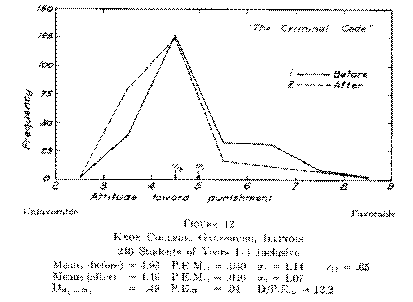
cant. The college group was less in favor of punishment of criminals than the high school group was before the film was shown and changed almost as much. In other words, a change in the direction of leniency from a position which was originally more in favor of leniency may be more sig
(33) -nificant than a slightly larger change from an original position which was more in favor of punishment.
Figure 13 gives the two frequency distributions before and after seeing "The Criminal Code" for the combined groups of Galesburg and Watseka. The statistical facts about the two distributions are given below.
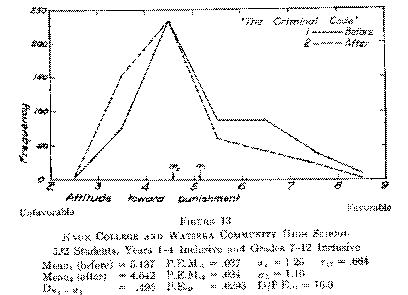
"Alibi" and punishment of criminals
The film "Alibi" tells the story of a police sergeant's daughter who sympathizes with crooks and believes that they are persecuted by the police. The picture finally shows the girl convinced that the gangster has not reformed, and she is disillusioned about persecuted crooks. This picture has been barred by the censor board of a large city because its effect was considered anti-social, We were interested
(34) in finding out whether the film had a measurable effect on the attitudes of high school children toward the treatment of criminals.
The scale of attitude toward punishment of criminals was given to 352 students in grades seven to twelve inclusive in the Aledo, Illinios, public schools. Aledo has a population of 2,200. The experiment was carried on with the assistance of Mr. L. C. McCarty, superintendent of the Aledo public schools, and Mr. R. E. Dahl, principal of the Junior High School. The scale was given on April 27, 1931, the motion picture was shown at a local theater on May 14, and the scale was given the second time on May 15
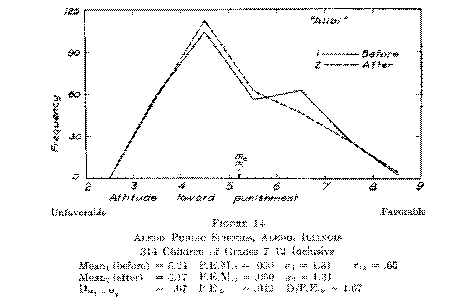
Figure 14 shows the frequency distributions of attitude before and after the children saw the film. The mean at-
(35) -titude of the group before was 5.24; after, 5.17, a change of .07 with a RED of .042, giving a ratio of the difference to the RED of 1.67. There was a slight change of attitude in the direction of leniency toward the punishment of criminals, but the change is not statistically significant.
We conclude, therefore, that the film "Alibi" had no measurable effect on the attitudes of the children toward punishment of criminals.
"The Birth of a Nation" and the Negro
"The Birth of a Nation," a picture very widely known a number of years ago, was returned to the screen in 1931 with sound accompaniment. It has been considered as powerful anti-Negro propaganda. We wished to study the effect of this picture on attitude toward the Negro, and with the coöperation of Mr. H. A. Dean, superintendent of schools in Crystal Lake, Illinois, a scale of attitude toward the Negro was given to 434 students in grades six to twelve inclusive in his school. Crystal Lake is a town of 3,700 people, but has no Negroes. Mr. Dean told us that, in all probability, very few of the children had known or even seen Negroes. The mean attitude of the group on the first application of the scale of attitude toward the Negro was 7.46. The range of the scale is from zero to eleven, with the higher scale values for the statements which are favorable to the Negro.
The attitude scale and the scale values for each statement are given below. (The scale values were not, of course, given on the form used.)
(36)
A STUDY OF ATTITUDE TOWARD THE NEGRO
Write your name here
Boy or girl_ Age _Grade
Father born in - Mother born in
(Naine of country) (Name of country)
This is a study of attitudes toward the Negro. On the other side of this page you will find a number of statements expressing different attitudes toward the Negro.
⇃ Put a check mark if you agree with the statement. X Put a cross if you disagree with the statement.
Try to indicate either agreement or disagreement for each statement. If you simply cannot decide about a statement you may mark it with a question mark.
This is not an examination. There are no right or wrong answers to these statements. This is simply a study of people's attitudes toward the Negro. Please indicate your own convictions by a check mark when you agree and by a cross when you disagree.
| 5.4 | 1. I am not at all interested in how the Negro rates socially. |
|---|---|
| 7.3 | 2. You cannot condemn the entire black race because of the actionsof some of its members. |
| 2.7 | 3. Under no circumstances should Negro children be allowed toattend the same schools as white children. |
| 0.8 | 4. The white race must be kept pure at all costs, even if the Negroes have to be killed off. |
| 8.9 | 5. Give the Negro time. Within the next fifty years he will astonishyou. |
| 4.3 | 6. The Negro should have freedom but should never be treated asthe equal of the white man. |
| 1.8 | 7. No person with the slightest trace of Negro blood should associate with white people or be classed as a white man. |
| 10.3 | 8. I believe that the Negro deserves the same social privileges as the white man. |
| 9.6 | 9. Give the Negro a high position in society and he will show himself equal to it. |
| 6.8 | 10. In a thousand years the Negro might become the white man's equal; then his social position should be equal to the white man's. |
| 4.7 | 11. I think the colored race should hold a somewhat lower social position than the white race. |
| 2.1 | 12. I can stand a "nigger" in his place but I cannot stand him as theequal of the white man. |
| 0.9 | 13. The Negro will always remain as he is--a little higher than the animals. |
| 10.3 | 14. The Negro should be considered as equal to the white man and be given the white man's advantages. |
| 7.9 | 15. Our refusal to accept the Negro is not based on any fact in nature but on a prejudice which should be overcome. |
| 6.5 | 16. The courts are far more unfair to the Negro than the real differences between the races justify. |
| 3.2 | 17. The Negro and the white man must be kept apart in all social affairs where they might be taken as equal. |
(37)
| 1.7 | 18. Negroes should not be allowed to associate with white people in any way. |
|---|---|
| 9.6 | 19. The white and colored races should enjoy the same privileges and protection. |
| 5.5 | 20. The Negro problem will settle itself without our worrying about it. |
| 3.6 | 21. The Negro should be treated and thought of as a servant for the white man. |
| 0.9 | 22. The Negro should be considered in the lowest class among human beings. |
| 10 | 23. By nature the Negro and the white man are equal. |
| 7.7 | 24. The Negro is perfectly capable of taking care of himself, if the white man would only let him alone. |
The above scale was given in the school on May 18, 1931. "The Birth of a Nation" was shown at a local theater on the afternoon of May 25 at a special performance for the
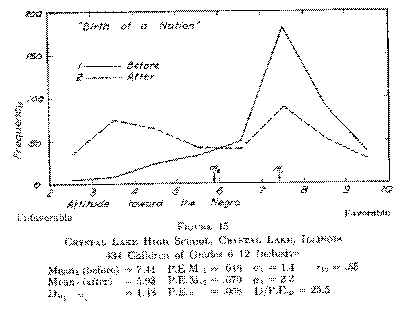
experimental group. The attitude scale was given again in the school on May 26.
The two frequency distributions, representing the at-
(38) -titudes of the group before and after they saw the picture, are given in Figure 15. The change is very striking, the average change for the group of 434 children being 1.48 scale steps. The difference is 25.5 X P.E.D. This is the largest effect found in any of the experiments we conducted.
The conclusion that the motion picture "The Birth of a Nation" had the effect of making the children less favorable to the Negro is undoubtedly justified. A later section of this report will give the persistence of the effect measured. It was interesting to find that the change in attitude was so marked and that, after an interval, the attitude of the group was still definitely less favorable to the Negro than before the film was seen.